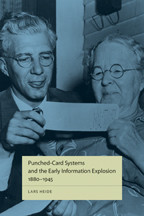
Reviews
The American Lab is highly recommended reading not just for science collections; but for anyone who would better understand the intersection of and connections between political, scientific, educational, and military communities.
Up to now, the growing lexicon of scholarship on the U.S. national laboratories has lacked work on the history of Lawrence Livermore National Laboratory, aside from one dissertation and a classified document. This book by a former laboratory director, which covers the defense laboratory's history from its beginnings to 2008, provides the first comprehensive, easily accessible account... Given the enormous national investment in this complex, the work and devices it produces, and its impact on research and development, Tarter's book offers crucial, previously missing information.
Today we know Silicon Valley as a veritable field of dreams for startups, but in The American Lab, the former director of Lawrence Livermore National Laboratory, C. Bruce Tarter, recounts how a culture that valued debate, questioning, and passion made Livermore not only the first successful startup in the San Francisco Bay Area but a uniquely American lab.
There are few books by authors who have had front row seats to the history of Cold War nuclear weapons laboratories. Tarter, who had firsthand contact with many of the key players, gives readers the feeling of actually being a member of the Livermore weapons design teams. He draws interesting comparisons with Los Alamos and describes the trials and tribulations of the fledgling program from the perspective of the scientists and engineers who were there.
This is a fascinating history of an iconic laboratory that created new directions for US nuclear weapons during the height of the Cold War. Tarter presents an insider’s view of a diverse array of scientific endeavors and the captivating stories of the events and the people behind these efforts.
While chronicling the history, culture, and people that created Lawrence Livermore National Laboratory, The American Lab provides important insights into the external events and underlying principles that have made the Lab one of the foremost science and technology institutions in the world. A great read!
The American Lab is a personal, clear-eyed, and readable account of the Lawrence Livermore story—a mix of science, patriotism, politics, engineering, and ego. Tarter makes an important contribution to understanding of the role of ‘big science’ in American life, and sets the stage for understanding the role of Lawrence Livermore and other national laboratories in shaping the future.
Tarter’s book is a fascinating look at the role of the University of California and the groundbreaking physicist E. O. Lawrence in the history of the US nuclear weapons program. Tarter gives the reader insight into some of the most important decisions and choices made at the Lab.
Nuclear weapons were a defining characteristic of the Cold War era and after, and the Livermore Lab is one of the most important but least understood of the places that made them. C. Bruce Tarter, a former Livermore director, provides the Lab’s first detailed history with insight and candor.
Book Details
Preface
Acknowledgments
Part I. Making the Cold War Cold, 1952-1971
Chapter 1. Origins
Chapter 2. Getting Started
Chapter 3. The Foundation of Deterrence
Chapter 4. Arms Control, Atoms for Peace, and
Preface
Acknowledgments
Part I. Making the Cold War Cold, 1952-1971
Chapter 1. Origins
Chapter 2. Getting Started
Chapter 3. The Foundation of Deterrence
Chapter 4. Arms Control, Atoms for Peace, and the Test Ban
Chapter 5. Organization and Evolution of the Laboratory
Chapter 6. Development of the Stockpile
Chapter 7. Nuclear Excursions
Chapter 8. Transition
Part II. Lasers, Lasers, Nothing but Lasers, 1971-1988
Chapter 9. Changing of the Guard
Chapter 10. The Nuclear Weapons Program
Chapter 11. Lasers
Chapter 12. The Energy Crisis and New Programs
Chapter 13. Evolution of the Broader Lab
Chapter 14. Star Wars
Chapter 15. End of the Era Part III. Renaissance, Repression, and Reorganization, 1988-2008
Chapter 16. End of the Cold War
Chapter 17. Post-Cold War Changes
Chapter 18. Early Days with the New Administration
Chapter 19. Stockpile Stewardship and the Presidential Decision
Chapter 20. Growth of the Lab
Chapter 21. The Troubles and Their Weathering
Chapter 22. Summing Up
Chapter 23. Transitional Years
Epilogue
Acronyms and Abbreviations
Bibliography
Index






